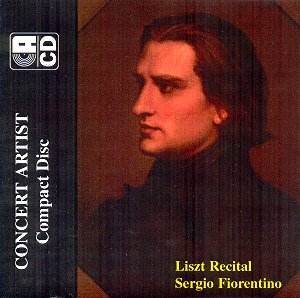Things are hotting up in the Fiorentino-Concert Artist/Fidelio
stakes. Not content with releasing a long delayed and previously unissued
set of the Transcendental Etudes they now continue with the Paganini
Etudes and bring the recital to over an hour’s worth of remarkable pianism
with the three Petrarch Sonnets and the Two Legéndes. Recording
were made in the Greenwich Borough Hall and in the Guildford Civic Hall
between 1962 and 1965 and have been digitally remastered to a very good
standard. These are never going to be sonically spectacular recordings
but to those who value superior musicianship there is a huge amount
to admire here, as ever with Fiorentino.
His playing of the Paganini Etudes is broadly consonant
with his playing on that earlier disc of the Transcendental Etudes;
greatly impressive if on a very slightly less majestic level. I find
his structural control and his humanity enormously persuasive. Pyrotechnics
are irrelevant for him unless technique and virtuosity are made to serve
the curve and dramatic interiority of the score. In the G Minor etude,
the tremolo study, his powers of structural concentration are immediately
apparent. Comparison with, say, the pre-War recordings of another legendary
Lisztian, Claudio Arrau, show that whilst Arrau is abrupt and bursting
with tensile strength and quick reflexes, Fiorentino has a deep-rooted
control of each Etude’s internal and external dynamic and that his are
readings of maturity and depth. His "integrationist" aesthetic
is illustrated best in the first study where he refuses to engage in
surface glitter, preferring the more lasting benefits of a long line.
In the octave study, No 2 in E Flat, he is considerably less overtly
theatrical than Arrau and also lighter on his feet, as it were, but
this is not to deny him those moments of glittering clarity that so
frequently illuminate Fiorentino’s playing. He doesn’t stint the drama
but he does make it less barrenly brazen. His quasi-operatic flourishes
here are entirely apposite, flecked with an admixture of wit. The third
of the Etudes, La Campanella, shows the stunning clarity of his
right hand, the trills exquisitely even and "hammered" with
poise. His intimacy is a marvel even if I did feel the conclusion rather
too dry and unalluring. The E Major Etude receives a reading of excellence,
no striving for effect, the weight of hand distribution expertly accomplished.
La Chasse lasts 2.41 in Fiorentino’s hands, roughly the same
as Arrau but Fiorentino manages to create a greater sense of narrative
space; he’s not as rhythmically incursive as Arrau, instead preferring
a more mellow, more leisurely sense of the work’s syntax, in terms of
its drama. He is less theatrical, less quicksilver, but equally is better
at bringing out the flute and horn sonorities of the score. In the Theme
and Variations finale one once more sees the essential rightness of
Fiorentino’s approach to Liszt, which is one that remained constant
throughout his career. His understanding and illumination of structural
cohesiveness is second to none; this is never pedantic or, in the worst
sense, didactic. Rather it is a constant commentary on and revelation
of the spine of the music.
The Petrarch Sonnets were recorded in August 1963.
In the first, No 104, one can explore as much as Liszt’s writing, Fiorentino’s
own gift of a simplicity born of experience and understanding. In No
47 we can witness the way in which he coalesces the wide variety of
moods. When Horowitz recorded it his huge Corinthian columns of bass
notes and his visceral, powerful passion engorged the piece with outsize
drama. Undeniably thrilling though it was this is simply not Fiorentino’s
way; he prefers a more horizontal delineation of the piece, less overtly
passionate, seeing it as a structure of semi-classical precision through
which animation pulses and grows. So too in the last of the three Sonnets
where he mines the music for a remarkable sense of interior life, an
ability given to few. The Deux Legéndes date from 1863 and derive
from St Francis of Assisi preaching to the birds and St Francis of Paolo
walking on the water. Fiorentino thrillingly animates the former, with
its colourful and suggestive imitative writing and in the latter derives
great layers of nobility and passion from the waves incident and completes
this Liszt recital as he began it – with concentration, passion controlled
through intellect, virtuosity subsumed to the work’s meaning and characterful
understanding.
Once more Humphrey Searle’s notes grace the booklet
and once again admirers of this remarkable pianist can investigate his
ever-growing legacy with confidence and undimmed admiration.
Jonathan Woolf
MusicWeb
can offer the complete Concert
Artist catalogue


